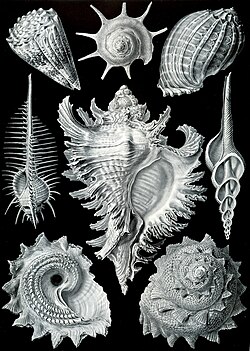Prosobranchia
This article includes a list of references, related reading, or external links, but its sources remain unclear because it lacks inline citations. (September 2025) |
This article needs to be updated. (September 2025) |

Prosobranchia[a] was a large taxonomic subclass of gastropods, which included sea snails, land snails and freshwater snails. This taxon dates back to the 1920s, but has since been proven to be polyphyletic (consisting of more than one lineage of descent). In biology taxonomy must reflect phylogeny and monophyletic groups are preferred; in other words, the classification of a group must reflect its evolutionary descent as far as that is known through studies of Morphology (biology) and genetic analysis, and must include a common ancestor and all of its descendants. Therefore, the taxon Prosobranchia with its multiple evolutionary origins is no longer considered suitable to be used.
One can still encounter this subclass used as if it is still valid in many texts and websites.[tone] Although Prosobranchia is no longer generally accepted as a taxon by people who study living Mollusca, still the term prosobranch is legitimately used as an anatomically descriptive adjective or noun, and the taxon Prosobranchia is still sometimes used by paleontologists.
The majority of marine gastropods are prosobranch, as are a few land snails and freshwater snails. The prosobranch gastropods include the majority of marine snails, among them conches, cones, cowries, limpets, murexes, periwinkles, volutes and whelks, as well as numerous freshwater groups, and some land snails with an operculum. Prosobranchs have their gills, mantle cavity and anus situated in front of their heart. Most prosobranchs have separate sexes.
Description
[edit]The majority of prosobranchs have an operculum, a corneous or calcareous plate situated on the dorsal surface of the foot. In many prosobranchs, the animal can completely close the aperture with the operculum.
The nervous system of prosobranchs is twisted into a figure 8 due to a developmental process known as torsion. The eyes are situated at the base of the tentacles.
Taxonomic context
[edit]The taxonomy of the gastropods is changing rapidly. The old classification (Johannes Thiele) divided Gastropoda into three subclasses: Prosobranchia, Opisthobranchia and Pulmonata. The subclass Prosobranchia (Henri Milne-Edwards) was further divided into the orders Archaeogastropoda, Mesogastropoda and Neogastropoda. The new version of the gastropod classification is explained in Taxonomy of the Gastropoda (Ponder & Lindberg, 1997).
References
[edit]- ^ Meaning gills in front (of the heart), in contrast to "opisthobranch" means gills behind (and to the right of the heart).
- Thiele, J., 1929–1935. Handbuch der Systematischen Weichtierkunde. 2 vols. 1154 p., 584 figs.
- Bieler, R. & P. M. Mikkelsen (eds.), 1992. Handbook of Systematic Malacology, Part 1 (Loricata [Polyplacophora]; Gastropoda: Prosobranchia). Smithsonian Institution and National Science Foundation, xviii + 625 pp., 470+1 text-fig. (Annotated English-language edition of: Thiele, J., Handbuch der systematischen Weichtierkunde, Teil 1). Also published, in 1993, by Gustav Fischer Verlag, Stuttgart/Jena/New York.
- Bieler, R. (1992). "Gastropod phylogeny and systematics". Annual Review of Ecology and Systematics. 23 (1): 311–338. Bibcode:1992AnRES..23..311B. doi:10.1146/annurev.es.23.110192.001523.
- Haszprunar, G. (1988). "On the origin and evolution of major gastropod groups, with special reference to the Streptoneura". Journal of Molluscan Studies. 54 (4): 367–441. doi:10.1093/mollus/54.4.367.
- Bieler, R. (1990). "Haszprunar's "clado-evolutionary" classification of the Gastropoda - a critique". Malacologia. 31 (2): 371–380.

